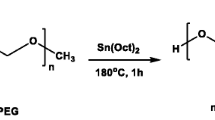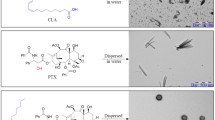Abstract
The objective of the present study was to prepare a polymeric drug delivery system with no burst effect. To attain this goal, doxorubicin (Dox) as an effective anticancer drug was loaded into poly(lactide-co-glycolide) (PLGA) nanoparticles (NPs) to improve the drug performance and also maximize the release period. After the synthesis process, the freshly made PLGA NPs with two different lactide-to-glycolide ratios (75:25 and 50:50) were evaluated physically and chemically. To determine the encapsulation efficiency, a centrifugation method was applied. Also, the drug loading effect on particle size, polydispersity index, and zeta potential was examined. The results indicated that the NPs had nearly the same diameters around 360 nm, and the entrapment efficiencies for 75:25 PLGA and 50:50 PLGA were reported around 39 and 48 %, respectively. A slight increase in all parameters was observed due to the increase of the drug loading content. The primary release was 7.91 % (w/w) and 14.70 % (w/w) for 75:25 and 50:50 drug-loaded NPs, respectively; no burst effect was observed. After 20 days, the drug release was around 70.98 and 62.22 % of the total entrapped drug for 75:25 and 50:50 drug-loaded NPs, respectively. Finally, it was found that Dox was an appropriate anticancer agent with good capability to be encapsulated in polymeric NPs and could be released from the carriers with no burst effect and favor rate.










Similar content being viewed by others
References
Yadav, A. K., Mishra, P., Mishra, A. K., Mishra, P., Jain, S., & Prasad Agrawal, G. (2007). Development and characterization of hyaluronic acid-anchored PLGA nanoparticulate carriers of doxorubicin. Nanomedicine: Nanotechnology, Biology, and Medicine, 3, 246–257.
American Cancer Society. (2009). Cancer facts & figures 2009. Atlanta, GA: American Cancer Society.
Chouhan, R., & Bajpai, A. K. (2009). Real time in vitro studies of doxorubicin release from PHEMA nanoparticles. Journal of Nanobiotechnology, 7, 5–16.
Husseini, G. A., Rapoport, N. Y., Christensen, D. A., Pruitt, J. D., & Pitt, W. G. (2002). Kinetics of ultrasonic release of doxorubicin from pluronic P105 micelles. Colloids and Surfaces. B, Biointerfaces, 24, 253–264.
Bromberg, L., & Alakhov, V. (2003). Effects of polyether-modified poly(acrylic acid) microgels on doxorubicin transport in human intestinal epithelial Caco-2 cell layers. Journal of Controlled Release, 88, 11–22.
Lebold, T., Jung, C., Michaelis, J., & Brauchle, C. (2009). Nanostructured silica materials as drug-delivery systems for doxorubicin: single molecule and cellular studies. Nano Letters, 9, 2877–2883.
Chavanpatil, M. D., Khdair, A., & Panyam, J. (2007). Surfactant−polymer nanoparticles: a novel platform for sustained and enhanced cellular delivery of water-soluble molecules. Pharmaceutical Research, 24, 803–810.
Weinberg, B. D., Elvin Blanco, H. A., Anderson, J. M., & Gao, J. (2007). Antitumor efficacy and local distribution of doxorubicin via intratumoral delivery from polymer millirods. Journal of Biomedical Materials Research. Part A, 81, 161–170.
Brzozowska, M., & Krysinski, P. (2009). Synthesis and functionalization of magnetic nanoparticles with covalently bound electroactive compound doxorubicin. Electrochimica Acta, 54, 5065–5070.
Nidhin, M., Indumathy, R., Sreeram, K. J., & Nair, B. U. (2008). Synthesis of iron oxide nanoparticles of narrow size distribution on polysaccharide templates. Bulletin of Materials Science, 31, 93–96.
Chavanpatil, M. D., Khdair, A., Patil, Y., Handa, H., Mao, G., & Panyam, J. (2007). Polymer−surfactant nanoparticles for sustained release of water-soluble drugs. Journal of Pharmaceutical Sciences, 96, 3379–3389.
Reddy, L. H., & Murthy, R. S. R. (2004). Pharmacokinetics and biodistribution studies of doxorubicin loaded poly(butyl cyanoacrylate) nanoparticles synthesized by two different techniques. Biomedical Papers of the Medical Faculty of the University Palacky Olomouc, 148, 161–166.
Reddy, L. H., Meda, N., & Murthy, R. R. (2005). Rapid and sensitive HPLC method for the estimation of doxorubicin in dog blood—the silver nitrate artifact. Acta Pharmaceutica, 55, 81–91.
Gao, J., Kou, G., Wang, H., Chen, H., Li, B., Lu, Y., et al. (2009). PE38KDEL-loaded anti-HER2 nanoparticles inhibit breast tumor progression with reduced toxicity and immunogenicity. Breast Cancer Research and Treatment, 115, 29–41.
Italia, J. L., Datta, P., Ankola, D. D., & Ravi Kumar, M. N. V. (2008). Nanoparticles enhance per oral bioavailability of poorly available molecules: epigallocatechin gallate nanoparticles ameliorates cyclosporine induced nephrotoxicity in rats at three times lower dose than oral solution. Journal of Biomedical Nanotechnology, 4, 304–312.
Gagliardi, M., Silvestri, D., Cristallini, C., Guadagni, M., Crifaci, G., & Giusti, P. (2010). Combined drug release from biodegradable bilayer coating for endovascular stents. Journal of Biomedical Materials Research B, 93, 375–385.
Janes, K. A., Fresneau, M. P., Marazuela, A., Fabra, A., & Alonso, M. J. (2001). Chitosan nanoparticles as delivery systems for doxorubicin. Journal of Controlled Release, 73, 255–267.
Gomez-Gaete, C., Tsapis, N., Besnard, M., Bochot, A., & Fattal, E. (2007). Encapsulation of dexamethasone into biodegradable polymeric nanoparticles. International Journal of Pharmaceutics, 331, 153–159.
Yoo, H. S., Lee, K. H., Oh, J. E., & Park, T. G. (2000). In vitro and in vivo anti-tumor activities of nanoparticles based on doxorubicin–PLGA conjugates. Journal of Controlled Release, 68, 419–431.
Sun, J. B., Duan, J. H., Dai, S. L., Ren, J., Guo, L., Jiang, W., et al. (2008). Preparation and anti-tumor efficiency evaluation of doxorubicin-loaded bacterial magnetosomes: magnetic nanoparticles as drug carriers from Magnetospirillum gryphiswaldense. Biotechnology and Bioengineering, 101, 1313–1320.
Shen, Y., Jin, E., Zhang, B., Murphy, C. J., Sui, M., Zhao, J., et al. (2010). Prodrugs forming high drug loading multifunctional nanocapsules for intracellular cancer drug delivery. Journal of the American Chemical Society, 132, 4259–4265.
Varshney, L., & Dodke, P. B. (2004). Radiation effect studies on anticancer drugs, cyclophosphamide and doxorubicin for radiation sterilization. Radiation Physics and Chemistry, 71, 1103–1111.
Kalaria, D. R., Sharma, G., Beniwal, V., & Ravi Kumar, M. N. V. (2009). Design of biodegradable nanoparticles for oral delivery of doxorubicin: in vivo pharmacokinetics and toxicity studies in rats. Pharmaceutical Research, 26, 492–501.
Lanks, K. W., & Lehman, J. M. (1990). DNA synthesis by L929 cells following doxorubicin exposure. Cancer Research, 50, 4776–4778.
Kim, E. S., Durairaj, C., Kadam, R. S., Lee, S. J., Mo, Y., Geroski, D. H., et al. (2009). Human scleral diffusion of anticancer drugs from solution and nanoparticle formulation. Pharmaceutical Research, 26, 1155–1161.
Author information
Authors and Affiliations
Corresponding author
Rights and permissions
About this article
Cite this article
Amjadi, I., Rabiee, M., Hosseini, M.S. et al. Synthesis and Characterization of Doxorubicin-Loaded Poly(Lactide-co-glycolide) Nanoparticles as a Sustained-Release Anticancer Drug Delivery System. Appl Biochem Biotechnol 168, 1434–1447 (2012). https://doi.org/10.1007/s12010-012-9868-4
Received:
Accepted:
Published:
Issue Date:
DOI: https://doi.org/10.1007/s12010-012-9868-4




